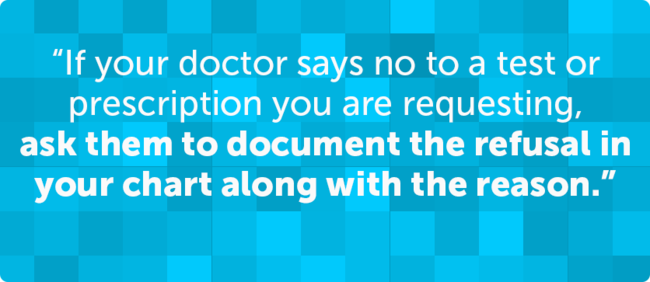
Powered By





 Continue with Facebook
Sign up with your email
Continue with Facebook
Sign up with your email
When It Goes Unseen | Taking Your Pain Seriously | Communicating With Your Doctor
As a woman with axial spondyloarthritis, getting a doctor to take your symptoms seriously can be a struggle. Physicians may downplay or dismiss your lower-back and joint pain as stress, anxiety, or depression, and send you home with medication for mood disorders. Axial spondyloarthritis, after all, has long been considered a “man’s disease” that’s rarely suspected in women.
New research is uncovering the truth about this chronic inflammatory disease: More women suffer from axial spondyloarthritis than previously thought. Lack of awareness in the medical community means many women go undiagnosed for years, putting them at increased risk for progressive disease activity, increased disability, and poorer quality of life.
“It took seven years and four rheumatologists to finally get diagnosed,” explained a female member of MySpondylitisTeam. “Unfortunately, a lot of damage occurred in that time.” Another woman echoed her frustrations with dismissive physicians: “When doctors say, ‘It's in your head,’ it’s because they haven’t listened to what you’re telling them. They should have a course for medical professionals on how to listen properly.”
Axial spondyloarthritis is an umbrella term for a family of inflammatory joint diseases which cause widespread pain, as well as stiffness in the entheses (the areas where ligaments and tendons attach to the bone). Axial spondyloarthritis typically affects the spine and pelvic joints, though it can also cause pain in other areas of the body. Ankylosing spondylitis is a severe form of axial spondyloarthritis in which new bone growth can cause the vertebrae in the spine to fuse and become rigid.
Up to 1 percent of the U.S. population, or 2.7 million people, have axial spondyloarthritis, according to the Spondylitis Association of America. Contrary to earlier research asserting that 90 percent of those affected were male, recent data indicates that women account for 25 percent to 33 percent of ankylosing spondylitis cases.
With more women included in clinical trials, researchers have discovered that one size of spondyloarthritis care doesn’t fit all. Women’s symptoms, bone and joint damage, level of inflammation in the blood, and response to treatments differ significantly from those of men.
Read Spondyloarthritis in Women vs. Men: What Are the Differences?
Despite recent classification of imaging criteria to account for women’s unique clinical profiles, many health care providers still brush off pain symptoms in the examining room. Not addressing a woman’s health concerns can have serious consequences.
It can take an average of nearly nine years for women to receive a proper spondyloarthritis diagnosis, compared to six-and-a-half years for men, according to a 2017 meta-analysis.
Women with axial spondyloarthritis are more likely than men to report widespread pain as a symptom, and those who do are twice as likely to be misdiagnosed with another condition. The most common misdiagnosis is fibromyalgia.
Misdiagnoses often lead to inappropriate treatment that fails to relieve pain or slow disease progression, and could lead to unnecessary health issues or side effects.
Read Is Axial Spondyloarthritis Underdiagnosed in Women?
Misunderstanding women’s symptoms is not unique to spondyloarthritis diagnosis. A growing body of research has found important differences in the symptoms and disease experience of men and women for heart disease, depression, chronic pain, and other conditions. More than 90 percent of women with chronic pain, for example, report experiencing biases in the health care system, according to a National Pain Report survey of 2,400 women.
Women are routinely told their symptoms are psychosomatic, and they are less likely to be prescribed pain medication. Those experiencing lower back pain, morning stiffness, and other spondyloarthritis symptoms may be referred to a gynecologist, surgeon, gastroenterologist, or psychiatrist — instead of a rheumatologist who can diagnose axial spondyloarthritis.
Racial bias can also be an issue. Black women are more likely to have their health concerns ignored or misdiagnosed, putting them at a higher risk of developing a chronic illness. Black women are often undertreated because of a false belief that Black people feel less pain than people of other ethnic backgrounds, which leads to inaccurate treatment prescriptions.
Doctors may also fail to recognize or properly treat axial spondyloarthritis symptoms in pregnant and breastfeeding women. The disease often flares in the second or third trimester, putting the woman and fetus at increased risk of complications. Postpartum flares can occur in up to 92 percent of women with ankylosing spondylitis six months after delivery. Axial spondyloarthritis treatments during pregnancy and breastfeeding can also differ from standard protocols.
Undiagnosed, undertreated, or incorrectly treated axial spondyloarthritis in women can lead to a greater disease burden and worse quality of life. That’s why it’s important for women with axial spondyloarthritis to speak up in the doctor’s office.
To get the best medical care, it’s important to be your own advocate. The more prepared, informed, and confident you are going into an appointment, the more respect and attention you’re likely to receive from a time-pressed doctor. Here are 15 tips to empower yourself for a doctor appointment.
1. Arm yourself with facts. Research your symptoms on reputable websites. Look for those sponsored by a government agency, a renowned hospital, a well-established nonprofit health organization, or a professional association. Examples of trustworthy sources include the National Institutes of Health (NIH), the Centers for Disease Control and Prevention (CDC), Cleveland Clinic, Mayo Clinic, the Spondylitis Association of America, and the American College of Rheumatology. The Arthritis Foundation offers a list of questions to ask your doctor if you think you have axial spondyloarthritis.
2. Know the difference between mechanical and inflammatory back pain. Spondyloarthritis symptoms are due to inflammation in the spine and sacroiliac joints, not a mechanical issue such as throwing out your back. Knowing the difference can help you ask the right questions and avoid unnecessary follow-up tests.

3. Keep a symptom or pain journal. Your doctor will want to know how — and how often — pain is affecting your daily life. Having a diary of your pain experience, rather than trying to reconstruct those experiences on the spot, can save a lot of time and show you mean business. Educate yourself about the wide range of symptoms of spondyloarthritis in addition to lower back pain, including uveitis (eye inflammation), fatigue, and brain fog. Record any symptoms you experience in your symptom journal.
4. Create a comprehensive medical history. Include a list of medical diagnoses, recent surgeries or procedures, medications, and treatments that have worked or failed. Knowing whether there is inflammatory arthritis or inflammatory bowel disease (such as ulcerative colitis or Crohn’s disease) in your family history may help reveal risk factors. The Society to Improve Diagnosis in Medicine offers a useful tool to get organized for your appointment. Your advance preparation will not only make the doctor’s job easier, it also leaves more time to discuss your condition after the exam.
5. Hone your symptom descriptions. Accurately answering a doctor’s questions about pain can improve the interaction and your doctor’s perception of how knowledgeable you are about your own condition. Prepare your answers in advance to the following questions:
The Cleveland Clinic provides a list of terms to help describe pain. The American Chronic Pain Association’s Quality of Life Scale is a useful tool to accurately describe your level of functionality.
6. Prepare a list of questions. Put them in order of priority in case time runs out before you can ask all your questions in person. If that happens, request a follow-up phone call. Emailing your doctor your remaining questions through your health care provider’s patient portal also provides an audit trail of your concerns and sometimes results in speedier answers.
7. Bring a friend or family member. A second set of eyes and ears is important for documenting the visit and asking follow-up questions. Your companion can take notes, press the doctor for answers on your behalf, and serve as a witness to any dismissive treatment.
8. Ask. Ask. Ask. You can’t ask too many questions, especially if you don’t understand what the doctor is saying. If you sense impatience, or the doctor stands to signal that the appointment is over, firmly stand your ground and respectfully press for answers. It may help to stand up as well, putting you eye-to-eye with your doctor. Again, you can also ask for a follow-up phone call or email conversation.

9. Press for tests. Be aware of the different imaging tests used to diagnose spondyloarthritis. X-rays typically show bone or joint changes (known as radiographic damage), but these changes are less likely to be visible in women with axial spondyloarthritis. Magnetic resonance imaging (MRI) can show symptoms of inflammation earlier in the course of axial spondyloarthritis than X-rays. Women are also less likely to show high levels of C-reactive protein (CRP), a blood test that can indicate inflammation. If you have pain but your imaging test comes back negative, don’t let the doctor wave you off. Ask for additional tests to work toward a diagnosis.
10. Understand the recommended treatment options. If drug treatments are prescribed, ask what guidelines were used to make this recommendation and what the doctor hopes to accomplish with this treatment. It’s important to know whether the medication will treat the underlying condition — for instance slowing the progression of the disease — or manage the symptoms only. Ask about any side effects, and guard against dangerous drug interactions by making sure the doctor knows about any other medications and supplements you take.
11. Record the conversation. Taking notes is good, but recording the conversation on your phone is even better. It documents the content and tenor of the doctor’s comments and behavior, and you can refer to it later if you forget exactly what was said. Laws vary by state on whether the doctor must be informed that you are recording.
12. Take copies of everything. Always ask for copies of test results, after-visit summaries, or other documents before you leave the appointment, in case you need to get a second opinion.
13. Get a clear explanation of what your doctor thinks is going on. If you’re hearing dismissive statements, such as, “Take some Ibuprofen,” “Lose weight and you’ll feel better,” or “You’re too young to have spondyloarthritis,” hold your doctor accountable. Ask: “Can you be 100 percent sure of this diagnosis without additional testing or consultations?”
14. Document the visit. Recap everything you discussed with the doctor in an email, preferably through your health care provider’s patient portal. If your doctor says no to a test or prescription you are requesting, ask them to document the refusal in your chart along with the reason. Make sure to include that information in your recap. This sometimes causes the doctor to rethink their initial refusal.

15. Trust your gut. If your doctor doesn’t make eye contact, talks too fast, treats you disrespectfully, rushes you out the door, or doesn’t take your concerns seriously, find a new physician. It’s not normal or OK to be treated this way. “No doctor knows your body as well as you do,” stressed one member of MySpondylitisTeam. “You must be your own doctor. If your doctor doesn’t take you seriously, try another, and keep trying.”
Get updates directly to your inbox.



 Continue with Facebook
Sign up with your email
Continue with Facebook
Sign up with your email
Become a member to get even more




A MySpondylitisTeam Member
I finally had to have 3 discs removed 2 years ago. My rehab went bad and now I have multiple Neuralgia. Lots of pain pills but at least I am mobile a bit.
We'd love to hear from you! Please share your name and email to post and read comments.
You'll also get the latest articles directly to your inbox.